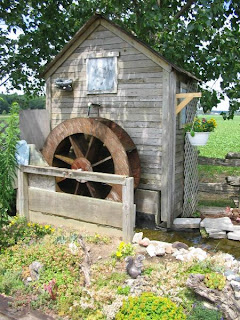Hydropower has many advantages--it is renewable, has relatively low carbon impact, and is fully dispatchable, i.e it can be turned on and off quickly whenever needed. So why aren't we hearing more about hydropower? Why aren't we building more of it?
Hydropower, at least in its conventional form, does have disadvantages, particularly the use conflicts. Water is an increasingly precious resource, and water for hydropower is sometimes water not available for agriculture or for fish migration. Hydropower dams create reservoirs that flood villages and archaelogical sites. It changes the character of rivers, destroying fish runs, limiting recreation and changing the very nature of the river.
However, there is more than one kind of hydropower.



Hydrokinetic hydropower (the approach used by Hydrovolts) entails merely placing turbines in flowing water, and avoids any modification to the watercourse like dams and weirs or diversions like penstocks. Old-fashioned waterwheels are the original hydrokinetic devices (although with a mill pond to create a waterfall they might more accurately be called low-head hydro or run-of-river hydro). The power is produced by the force of the flowing water on the turbine rotor; no head of water is required.
Hydro Green Energy is another company producing such devices, although at a larger scale, using permanent installations and only in the outflows of existing dams.
Micro-hydro refers to hydropower of whatever kind that produces small amounts of power (again variously defined), and may mean low-head, run-of-river, or hydrokinetic devices.
Other hydropower terms are specific to the location. Wave energy refers to a different class of devices for making power from waves in the ocean or on large lakes. Tidal energy uses hydro devices (often hydrokinetic) to make power from tidal flows. Ocean currents such as the Gulf Stream can be harnessed using hydrokinetic devices as well.
The Hydrovolts turbine is a true hydrokinetic device. It could also be termed run-of-river because it doesn't need a reservoir or dam to operate. It can also be used as a low-head hydro device in irrigation canals next to a weir or other check structure. It is micro-hydro because it is designed for small scale, distributed power generation of 5-25kW in a typical flow.
Regardless of how one chooses to name it, the Hydrovolts approach avoids the problems that have prevented more widespread adoption of additional hydropower generation. Because it uses no dams or reservoirs, there is little impact on other users of the water in the flow. Without dams, fish and boats can continue to navigate freely. Water can be pumped as needed for irrigation.
Hydrokinetic hydropower--renewable, abundant, low impact, fish-friendly, no greenhouse gas emissions--let's build more!









No comments:
Post a Comment